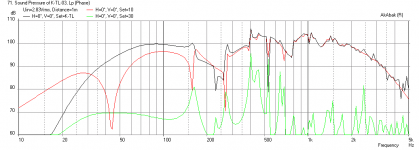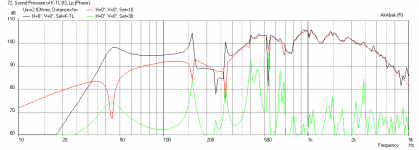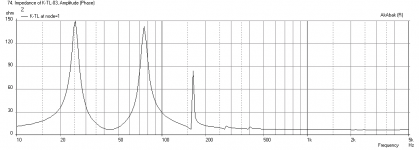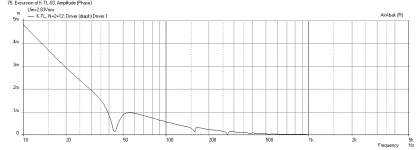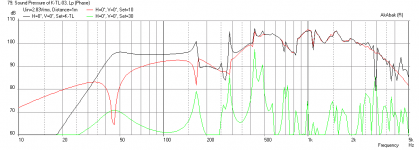Not sure why architectural styles are being discussed - these names and period terminology have nothing to do with the sound. The sound is really what it is all about with the Karlson. Having studied the actual shape and function of the K15 thoroughly as to be able to model it in AkAbak using a series of about 40 nodes, I can say that the form follows function. Karlson happened to develop it in 1940's and 1950's but if he did it today it would look very much the same.
Have a look at who originally coined the term "form follows function" and some of his buildings and his pupils buildings (hint: Louis Sullivan and Frank Lloyd Wright).
Form follows function-that has been misunderstood. Form and function should be one, joined in a spiritual union.
Frank Lloyd Wright
If you look at the requirements and how a speaker is typically built given Karlson aperture (which really was not invented by Karlson but adapted from standard microwave transmission line and antenna theory), you will see that the K15 shapes is one of the solutions. The requirements include: compactness, easy to construct, high acoustical coupling efficiency between driver and air, large bass gain bandwidth, good directivity, and placement on the floor. Thus compactness requires folding the path, easy to construct requires rectilinear cuts and a box like final shape, high coupling efficiency makes the design a dual chamber reflex and tapped horn hybrid, wide bass gain uses the K aperture coupler on the exit, good directivity requires K aperture to be placed vertically oriented and on the front with the apex at the top so that HF disperses widely and bass utilizes floor loading to enhance gain. Floor placement requires the driver to be tilted up to improve directivity of HF and floor placement with large end of slot at bottom requires driver to be at lower end of box rather than on top of box. All these design features as you can see, follow function and engineering requirements not fancy form requirements.
I'm not saying that there aren't perfectly good reasons for every choice made in the design
I'm not saying it's worse for looking like something from the 50's and 60's.
On the contrary, I love the period and think that people where probably generally less stale and conformist in their taste back then. And some of the best engineering and most exciting concepts in Hifi dates from that period.
It's the sheer weirdness (for lack of better word) and the collection of a number of aspects that I think dates it. Something like that would never fly just 10 or 20 years later.
Some of the aspects INPO are:
- The use of a slanted baffle.
- Large coaxial or fullrange (went out of style for a long time).
- Combination of straight and curved lines in that way. Later the wings would have been hidden by a grill or been done horizontally.
- Formfactor of the box.
- The rather strange bandpass, shelving system and internal geometry of the box.
Regarding why the design looks "dated" it perhaps was built with too much from the school of form follows function. Perhaps if some oblique angles and a slightly slanted cabinet were made vs rectangular prism like shape it would immediately change the architectural style period. However that would violate the requirement of easy to construct via rectilinear cuts. The only non rectilinear cut is the arc in the K aperture itself but that is the only one and is needed by a functional requirement - not architectural design or form requirement.
The things you suggest would make it even more googie (hence the use of "soft").
A speaker done today would probably have the driver mounted at ear hight (to shoot over furniture) and use a reflector for HF dispersion and use a completely separate bath for augmenting the bass. The dip in the upper bass of the current design is probably from the use of parallel walls in the K-slot chamber.
Last edited:
the first dip can be eased out - parallel sidewalls probably contribute to the 2nd dip. A proper modern Karlson-coupler can include the slotted pipe waveguide driven by compression driver, which imo can sound airier and more natural than a CD-waveguide.
Karlson's 1951 patent application may suggest he had already worked with a different aspect. Fig 3 looks to have a lot of air mass at the coupler's top - how does that affect things vs a narrowing cross-section at the top?
1951 Fig. 3
one of Carl's test-boxes
FWIW I like the original aspect a lot
Karlson's 1951 patent application may suggest he had already worked with a different aspect. Fig 3 looks to have a lot of air mass at the coupler's top - how does that affect things vs a narrowing cross-section at the top?
1951 Fig. 3
An externally hosted image should be here but it was not working when we last tested it.
one of Carl's test-boxes
An externally hosted image should be here but it was not working when we last tested it.
FWIW I like the original aspect a lot
An externally hosted image should be here but it was not working when we last tested it.
Last edited:
X - have you already simulated BetsyK in the "Karlsonator 8/SuperT##$"? does it go a bit below 50? BetsyK has very nice vocal production
The Betsy K can work in a Karlsonator 8 (aka, Super TW@T) but it does not have a flat bass shelf. However, there is still a lot of output at 50 Hz. I approximated the Karlsonator 8 by scaling the fullsize by 0.95 in vertical/depth and 0.87 in width.
Attachments
I will run the FE206EN when I get to my computer. I have been eyeing ABEC3 - which combines AkAbak's lumped element model with finite element analysis so that you can put in true 3-dimensional effects. This would be real interesting to see what is really going on inside the K15. Is it a DCR with hybrid BVR or a ML-QWTL? Also, the full impact of the Karlson aperture can be simulated and effect of spatial dispersion and directivity can be seen. Can't justify buying it as this is hobby and demo version doesn't let you save.
Interesting this informed discussion of visual design and acoustic design (actually it should be termed "versus" one another).snip
I think If you presented a photo, or perhaps more fairly a line drawing of a Karlson cab to average people on the street and asked them to place it in time, a huge percentage would get it right from looks alone and virtually no one would say it was from today.
snip
I was lucky to have a 15 inch Karlson from around 1956 for a dozen years. Liked it a whole lot but I have no good way to compare it to my stuff today. Sure impressed my friends and played bass really nice with a reasonably good Philips 12 inch driver.
Back to visual design. Karlson claimed the curve was something out of his radar/microwave engineering. Not a visual design from Pinninfarina like the good cars from that era.
Vomit warning: The Karlsons I saw around were formica. Mine was yucky red maple formica. Leonard, the NYC store where I bought it had dozens of their drivers housed in Karlsons, in blond-wood-grain formica, along the top shelf below the ceiling, upside down. At that height and angle, played beautifully to customer's heads standing around the store.
But in relation to the tapped horns so loved on this forum, is there any connection? My guess is that the Karlson (like a lot of designs and certainly true of drivers themselves) is kind of a hodge-podge of elements. Is one of those elements the transmission-line-like phase-addition trick we see in THs? And the added internal ports maybe makes it smarter than the usual DIYAudio TH.
BTW, the Karlson drove Paul Klipsch to fits of derision. I don't know how much competition he felt it was (some, at least). But he tested it and claimed it was multi-resonant - which is fair enough. (I have the letter and curves he sent me somewhere. I wonder if I could sell it on eBay like all the other trivia with "Klipsch" on it?)
Ben
Last edited:
FE206EN in 8 inch Karlsonator
Freddi,
Here is the sim of the FE206EN in an approximation of the Karlsonator 8 (scaled length and depth by 0.95 and width by 0.87). The frequency response looks good - it has a nice flat bass shelf with a little bass peak overshoot at 45 Hz. The impedance has some really high peaks as expected from low Qts high Bl motor - this will need an amp capable of high impedance loads - like a tube amp. The driver cone displacement, however, is problematic - it is in a runaway mode below 45 Hz. You will need a line-level high pass filter between the preamp and power amp (or a big fat cap at speaker level) or you risk blowing the driver with more than a few watts at 30 Hz. The stated xmax is only 0.8 mm.
If you were to scale the original Karsonator by 0.90X in depth and height and by 0.80X in width and the vent by 0.80X additionally, you can get a pretty nice response - last plot. The displacement is somewhat reduced.
not shabby! - how about the strong motor FE206EN in the same Karlsonator? fwiw FE206EN was punchy in the old K12 and sounded better on a Chinese drum CD than my Klipschorns - - - here's something - does it link up with akabak?
ABEC3
Freddi,
Here is the sim of the FE206EN in an approximation of the Karlsonator 8 (scaled length and depth by 0.95 and width by 0.87). The frequency response looks good - it has a nice flat bass shelf with a little bass peak overshoot at 45 Hz. The impedance has some really high peaks as expected from low Qts high Bl motor - this will need an amp capable of high impedance loads - like a tube amp. The driver cone displacement, however, is problematic - it is in a runaway mode below 45 Hz. You will need a line-level high pass filter between the preamp and power amp (or a big fat cap at speaker level) or you risk blowing the driver with more than a few watts at 30 Hz. The stated xmax is only 0.8 mm.
If you were to scale the original Karsonator by 0.90X in depth and height and by 0.80X in width and the vent by 0.80X additionally, you can get a pretty nice response - last plot. The displacement is somewhat reduced.
Attachments
thank you very much - the tweaked graph looks very good and pretty deep response
in practice, FE206EN is well behaved in a Karlson K12 and with the material I played (all digital - no turntable), no problems with excursion with an AlephJ clone or even my 250 watt Crown.
FE206EN was well behaved in the K12 - moreso than W8-1772 which was somewhat less "loud" - I'm not sure it was the longer stroke of 1772 or its lower Z pulling more power below cutoff but the Fostex barely moved even at goodly levels on drum - watching 206EN and listening, I'd give it 2mm useful one-way stroke (may be compressing). 206EN is my overall fave fullrange driver so far for the classic K12. 1772 liked a smaller ("SK8") K-coupler - it was kinda like K12's rear chamber was too large for best power handling with 1772. On some material, 1772 would move quite a bit further than 206 - but it wasn't useful motion. A good classic K will make a lot of sound without much if any visible cone motion - probably has something to do with driver compliance of course.
in the Karlsonator8, a high pass filter may be helpful
my biggest tube amp is a Mesa 400 - 6 tubes push-pull parallel per channel
in practice, FE206EN is well behaved in a Karlson K12 and with the material I played (all digital - no turntable), no problems with excursion with an AlephJ clone or even my 250 watt Crown.
FE206EN was well behaved in the K12 - moreso than W8-1772 which was somewhat less "loud" - I'm not sure it was the longer stroke of 1772 or its lower Z pulling more power below cutoff but the Fostex barely moved even at goodly levels on drum - watching 206EN and listening, I'd give it 2mm useful one-way stroke (may be compressing). 206EN is my overall fave fullrange driver so far for the classic K12. 1772 liked a smaller ("SK8") K-coupler - it was kinda like K12's rear chamber was too large for best power handling with 1772. On some material, 1772 would move quite a bit further than 206 - but it wasn't useful motion. A good classic K will make a lot of sound without much if any visible cone motion - probably has something to do with driver compliance of course.
in the Karlsonator8, a high pass filter may be helpful
my biggest tube amp is a Mesa 400 - 6 tubes push-pull parallel per channel
An externally hosted image should be here but it was not working when we last tested it.
Last edited:
hey Moray - my 206EN which is about the same, sounded very good in the little "SK8" and exciting bass-wise in the old K12 "Karlsonette".that combo sounded clearer on "The Spirit of the Chinese Drum" cd's drums than my Klipschorns. The 6- slit vent K12 cabinet should sound as good but measure worse if driven with sine-wave. I think my later K12 with 4 wider slits would be a good vent. A Karlsonator should go lower than a K12 - but the K12 with 206 is powerful within its range.
Hi xrk971,
Wow, you are productive, seriously low bass from a Betsy K (Post #58), now that's impressive. As to 15" drivers: a LAB15 should give you a smaller box, but, would a LAB15 in a scaled Karlsonator have enough high end to cross over to an Altec 511B (~500-800Hz)? I'm still trying to get my head around the AkAbak modelling (please, check your PM box).
Regards,
Wow, you are productive, seriously low bass from a Betsy K (Post #58), now that's impressive. As to 15" drivers: a LAB15 should give you a smaller box, but, would a LAB15 in a scaled Karlsonator have enough high end to cross over to an Altec 511B (~500-800Hz)? I'm still trying to get my head around the AkAbak modelling (please, check your PM box).
Regards,
in the standard Karlson K15, lower mass 15s with reasonably strong motor seem to provide the most life-like quality - - for instance an Altec 421-8A makes a K33 sound like a cheap toy. xrk971 will have to comment on the Lab15. - personally I'm not fond of higher mms 15s carrying vocals but have limited experience. Here's a 15 which I'd consider a bit heavy for K15 but its compared at Partsexpress favorably to a 2226 and its price isn't horrible plus the on-axis data provided looks favorable - maybe its good for a Karlsonator15 - its qts is rather low - but that may be good
B&C 15NDL76 15" Neodymium Woofer
http://www.parts-express.com/pdf/294-683.pdf
http://www.parts-express.com/pe/showdetl.cfm?partnumber=294-683
B&C 15NDL76 15" Neodymium Woofer
http://www.parts-express.com/pdf/294-683.pdf
http://www.parts-express.com/pe/showdetl.cfm?partnumber=294-683
Last edited:
Hi xrk971,
Wow, you are productive, seriously low bass from a Betsy K (Post #58), now that's impressive. As to 15" drivers: a LAB15 should give you a smaller box, but, would a LAB15 in a scaled Karlsonator have enough high end to cross over to an Altec 511B (~500-800Hz)? I'm still trying to get my head around the AkAbak modelling (please, check your PM box).
Regards,
Thanks. It's easy to be productive with sims. It was good to actually build something again with the mini K'nators. I am really enjoying them right now. Powered with my little class D TPA3116D2 amp (which by the way, you can buy as an assembled pc board from China for $24 ahipping included on eBay - that is Lepai territory but 100x better sounding) and a CD player - some of the best cleanest sounding tracks I have heard in a while
from Dave Brubeck's "in their own sweet way" album.
I Don't know what a LAB15 is?
Let me know if you need help with AkAbak.
Regards,
X
Last edited:
hi X - it appears Eminence's LAB15 is high mass (308g mms) lower efficiency subwoofer type http://www.parts-express.com/pdf/290-575s.pdf
that amp must be FAB! - gotta get one sometime - got a Lepai for a crude boombox project but not played with it yet
that amp must be FAB! - gotta get one sometime - got a Lepai for a crude boombox project but not played with it yet
seriously low bass from a Betsy K (Post #58), now that's impressive.
would a LAB15 in a scaled Karlsonator have enough high end to cross over to an Altec 511B (~500-800Hz)?
That in and of itself isn't all that impressive since a MLTL has no trouble matching it, but I'm guessing the K has less net Vb. A comparison would be interesting though
Horns in general and the 511 in particular, needs a minimum of an octave of 'flat' overlap unless XO'd up around 1200 Hz, so based on the published plot it's only good up to ~400 Hz once smoothed out.
GM
- Home
- Loudspeakers
- Full Range
- Karlsonator
